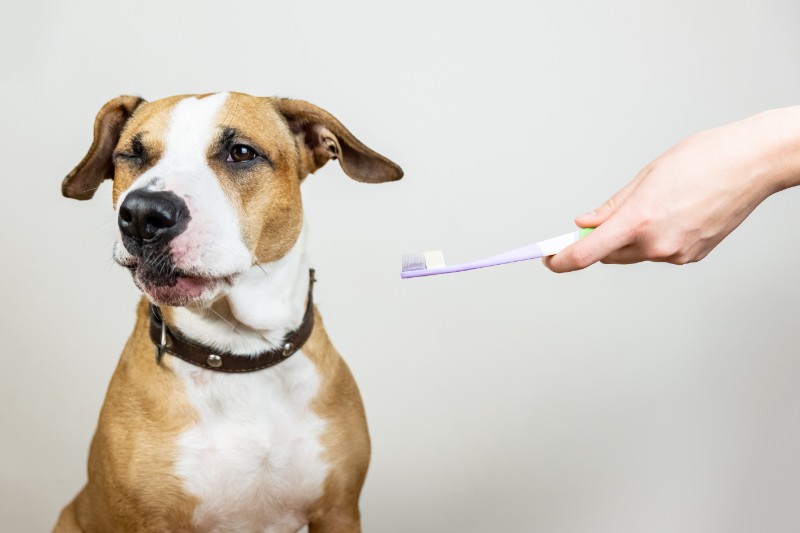

Your pet may not need to smile for the camera, but their teeth do matter. If left untreated, what you may think of as normal “doggy breath” can quickly progress to full blown periodontal disease.
Also known as dental disease, periodontal disease in pets is the progressive inflammation of the supporting structures of the tooth. It may come as some surprise that this is the most commonly diagnosed condition in pets today. In fact, by the time pets are 3 years of age, over 85% of them show signs of the condition. Luckily, periodontal disease is preventable, with a team approach.
How Periodontal Disease in Pets Happens
Periodontal disease in pets is progressive, and many pet owners don’t even know it’s a problem until it’s advanced. That’s why we recommend regular dental exams, which occur as a part of your pet’s annual preventive care exam.
Here’s how it happens:
- Bacteria in the mouth combine with food particles to form plaque, which sticks to the teeth
- Minerals in your pet’s saliva bond with the plaque, causing it to harden into tartar.
- The bacteria then work their way under the gumline, causing gingivitis
- Once under the gumline, the bacteria erode the supporting structures of the tooth and bone below (periodontitis), resulting in tooth loss.
- Bacteria can then be absorbed into the bloodstream and can cause systemic disease of the heart, liver, and kidneys, and can make diabetes regulation more difficult as well.
Signs of Pet Periodontal Disease
Pet owners often have a difficult time noticing pet dental disease. You may observe the following:
- Pawing at the mouth
- Drooling
- Pain or discomfort while eating
- Disinterest in chew toys or hard kibble
- Red, bleeding or swollen gums
- Chewing on one side of the mouth
- Loose teeth
- Discolored teeth
Your veterinarian can observe certain signs, such as gum inflammation, with a thorough dental exam. But, because periodontitis occurs below the gumline, general anesthesia is needed to completely assess your pet’s dental health.
Treating and Preventing Periodontal Disease in Pets
Early periodontal disease can be treated with a thorough cleaning above and below the gumline. During the cleaning, rough tooth surfaces will also be polished to eliminate areas where plaque may accumulate. Other techniques for treating advanced disease may include surgical care such as:
- Planing
- Crown restoration
- Root canal
- Extraction
There are several techniques used to prevent periodontal disease in pets, and they work best combined. Regular dental exams and cleanings are recommended for most pets. Oral exams should occur every year, and the frequency of cleanings will depend upon your pet’s general health and the level of dental disease seen. This care can allow us to examine every tooth and catch small problems early, before they become advanced.
Anesthesia is a necessary part of dental cleanings. Anesthesia free dental “cleanings” are ineffective since we cannot clean under the gumline without your pet’s full cooperation. Some pet owners express concern about the anesthetic risk. Fortunately, anesthesia has never been safer, thanks to advanced anesthetic protocols, safer anesthetics, and human grade monitoring equipment. Our team takes your pet’s safety and comfort seriously.
Daily toothbrushing is a wonderful way to prevent plaque and tartar buildup in between dental cleanings. Our skilled technicians can give you a demo in our office.
By using a team approach, we can together prevent periodontal disease in your pet. As always, our team is here to answer any questions or concerns about your pet’s health. Give us a call, we are happy to help!
